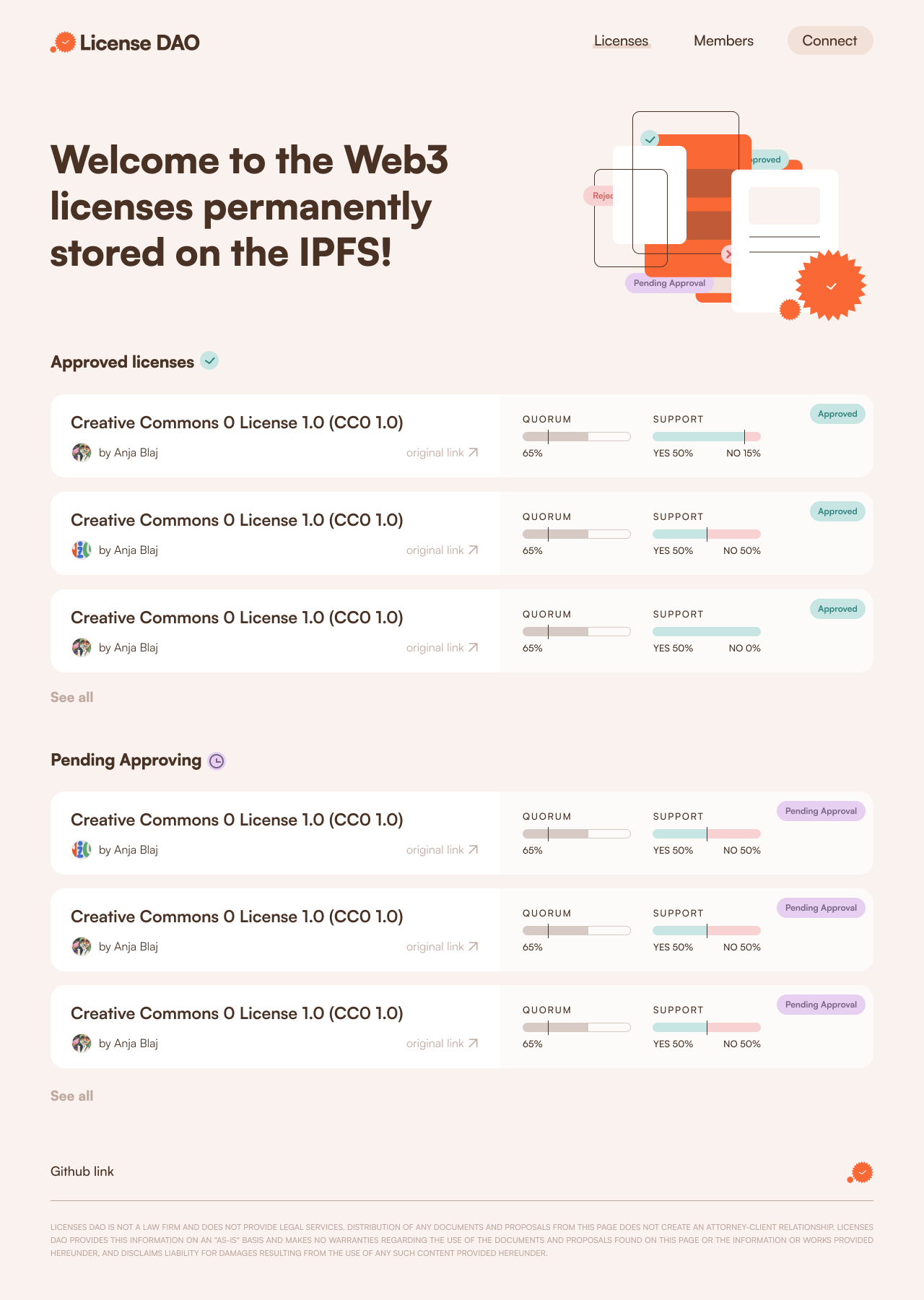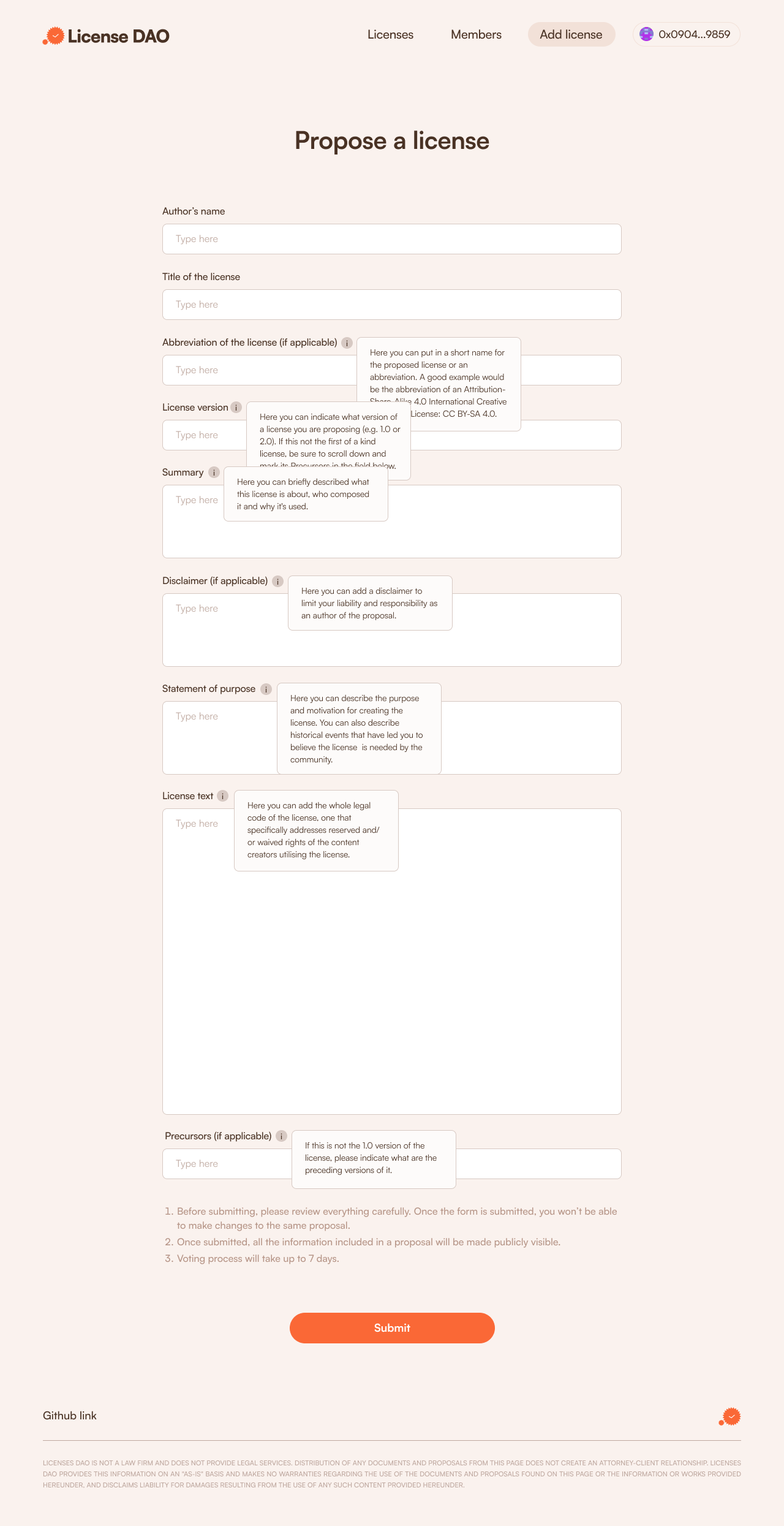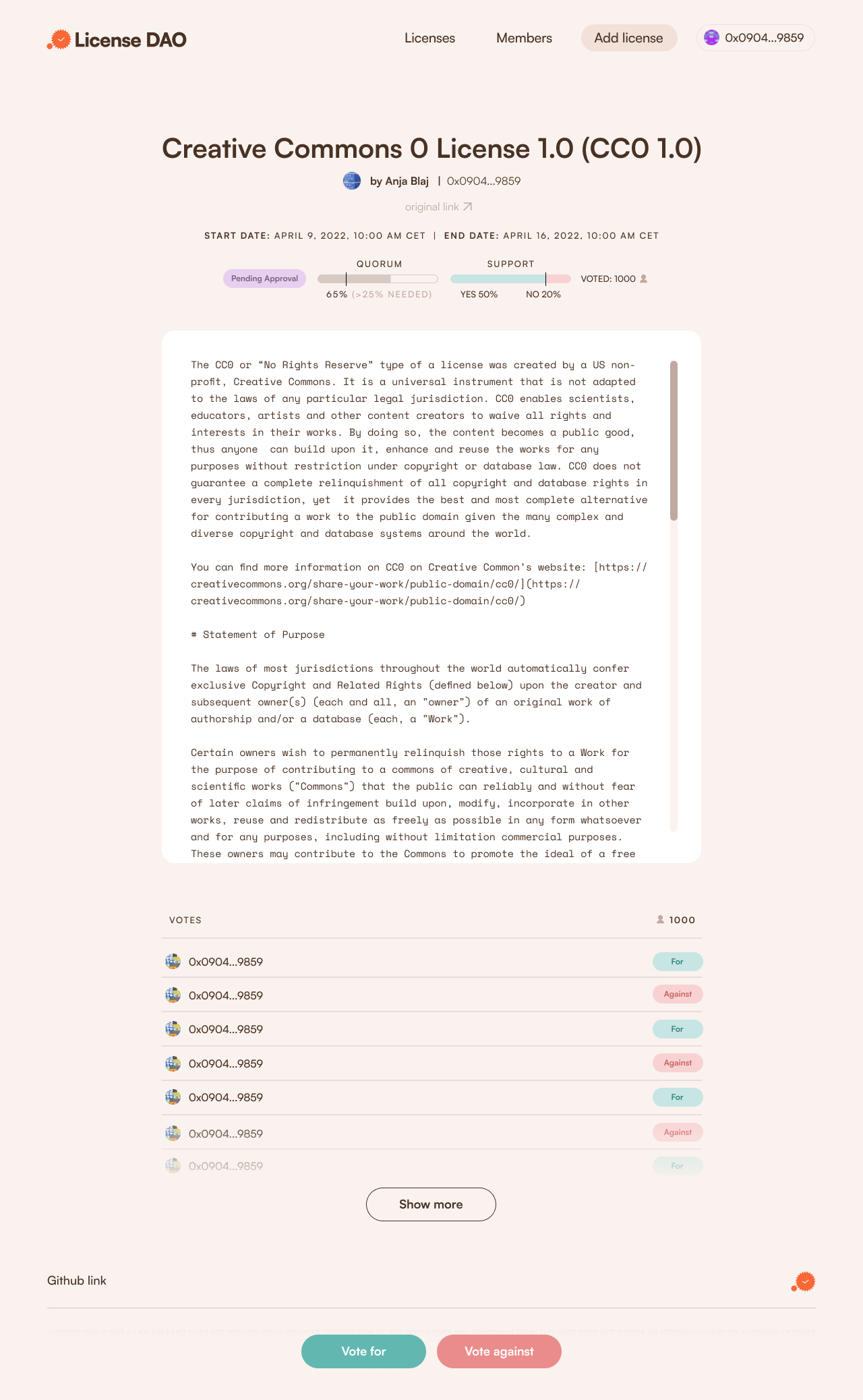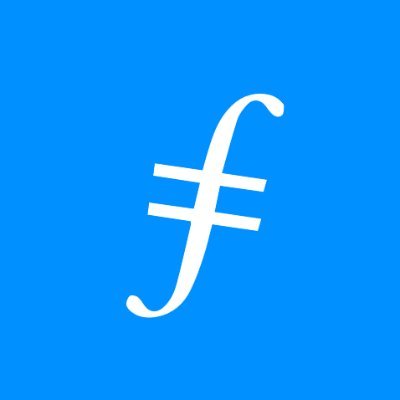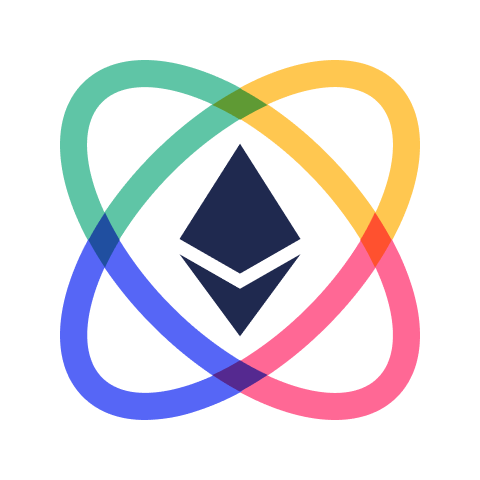License DAO
LicenseDAO offers a repository of licenses residing on IPFS so developers, platforms, collectors and content creators of Web3 community can optimise their choice of permissions and tailor their rights in a simple, standardised and efficient way.
Project Description
- IPFS Stored Licenses
Everything we publish on web pages is licensed. One way or another. Copyright, GNU License, CC0 license, CC BY license, or a very specific platform-native license mysteriously concealed somewhere within the Terms linked at the bottom of a page.
As we build decentralised infrastructure and digital assets, we empower a whole new type of economy, yet we reserve the rights or relinquish them through a reference made to the legal text which is crafted, published and managed rather centrally.
Even the most open licenses out there, such as “No Rights Reserved” better known as “CC0 Licence”, used by the devs proposing EIPs, or composing repos on IPFS and Ceramic GitHub, usually contain a link redirecting a reader to the Creative Common’s website where CC0 license is further described.
This submission proposes we put the licenses texts on the IPFS and eliminate the risks of the text being changed or no longer available without the creator’s knowledge. We address why storing it on the IPFS is necessary and how it holds the potential to provide additional support and protection to NFT issuers and owners. LicenseDAO aims to create a set of licenses with modular terms and conditions in order to enable artists to increase the value of their NFT and other digital content by associating additional rights with them (e.g. the right to create derivative works or to allow for the commercial usage of the underlying works). Our solution will allow for any licensed rights to be granted, only and exclusively, to the current holders of an NFT as well as other members of the Web3 community accessing and utilising digital assets. The solution also allows such assets to be transferred automatically to the new token holders every time the NFT is being transferred or when another digital asset changes the hands of the owner.
Finally, the submission describes how we tap into collective intelligence and make such licenses available through a License DAO, which makes use of the IPFS storage to secure the licensing text and thus allows for a simplified and standardised license adoption.
- NFT Licenses
Much ink has been spilt over the intersection of the NFTs and copyrights. While some creators don’t really care much about what rights they provide to collectors, others carefully examine the Terms of Service dictating how art is to be licensed. It should be noted that creators may also override such terms and link a specific IP license directly in their NFT metadata. However, by doing so, they risk that their choice will not be made visible on another platform, as platforms are not yet fully interoperable and aligned, thus do not offer the same level of protection to their users even though they are simultaneously displaying their NFTs.
In order to provide a more stable environment for both, NFT platforms and their users, one needs to consider a licensing structure that resides on-chain and thus allows for more universal recognition and execution of reserved rights.
This necessarily brings us to IPFS storage, which serves as a decentralised repository of licensing texts, that could not only be stored as plain text, but also broken down into attributes that trigger further actions when certain conditions are met. NFT marketplaces and owners were so far limited in their ability to execute a more complex format of license. With on-chain licenses, one may not only receive royalties with every recurring sale of the NFT, but may also be entitled to a specific revenue share when the art is displayed and used for commercial purposes.
The lack of appropriate license storage, architecture and management made such complex relationships impossible and to a large extent, this was due to a limited understanding of how we could use distributed networks and protocols to adapt the legal implications.
Indeed, putting licenses on the IPFS means we are building a global repository for the legalese that can be equally recognised (and executed) as any other legal text. Building it, means we’re making room for greater legal certainty as such a repository can be much more reliant, effective and better preserved.
- Public Goods
Such a repository can not only be used for the NFT market. It can very much help the protection of the public domain. In a recent interview led by Karl Floersch, Vitalik answered a question about what would the world look like if we didn't have public goods. His answer was simple: “Chances are you'd probably be dead of some stupid disease by now.” Public goods consist of creative work to which no exclusive intellectual property rights apply. In some cases, those rights (e.g. trademarks, patents, etc.) may already be expired, forfeited, expressly waived, or may be inapplicable. Vitalik is very much on point, in some cases, the exclusion or inapplicability of intellectual property rights has saved our lives. Discoveries, scientific theories, mathematical equations, diagnostics and surgical matters or inventions regarding medical treatments (except products produced for such treatments) simply cannot be protected with intellectual rights. But it’s not just the medicine or scientific theories, examples of public goods include the works of Leonardo da Vinci, Shakespeare, Wolfgang Amadeus Mozart, Newton’s formulas, and even cooking recipes and computer software code (in some cases).
Public goods benefit humanity at large and while parts of our broad Ethereum community focus on retroactive public goods funding, this proposal focuses more on standardisation of interface and potential licensing schemes for describing and enforcing the rights associated with such category. We propose that such standardisation can further be used for more complex structures with detailed revenue splits and distributions of royalties associated with NFTs. With this proposal, we aim to build a baseline for a subset of more complex licenses offering modular terms and conditions which will enable creators (authors) to define the limitations, rights and obligations imposed on their creative work. We do not wish to reinvent the wheel, thus we’ll start with best practices and focus our attention on some of the most recognisable structures and concepts - Creative Commons Licenses.
- Creative Commons Licenses
Most of the NFT creators and owners are concerned with the right to display their work publicly, reproduce, redistribute, or otherwise exploit that work. In other words, there are persisting questions about the need to mention the original author when such work is displayed, obtain consent for such display, and whether one can further resell or use it for commercial purposes (e.g. print the image on a T-shirt that is sold commercially).
While such intellectual property rights usually fall under the jurisdiction of each specific nation-state, or a specified license attached to the NFT one way or another, one can observe much less fragmentation and pluralisation within the public domain when looking at it from the global perspective. To a large extent, kudos for that goes to Lawrence Lessig and Eric Eldred, who designed the Creative Commons License back in 2001 as a response to discrepancies between copyright laws and public domain status. While developed and vastly recognised in the U.S. from the beginning, the latest Creative Commons License 4.0, introduced in 2013, was drafted after broad consultation with a global network of affiliates and has been written to be internationally recognised, thus much more compatible with the cosmopolitan Web3 domain.
Creative Commons licenses are manifold. Each Creative Commons license differs by several combinations that condition the terms of distribution. There are four "baseline rights" depicted as follows: Attribution (BY), Share-Alike (SA), Non-commercial (NC), and No derivative works (ND).
The combinations of these rights resulted in six licenses that are most commonly used in practice. While combinations pertain to more complex relations, through which authors demand recognition on the market when their creative work is displayed, or demand certain limitations to be observed and obeyed, Creative Commons also offers a specific license for works, which fall into the public domain. The CC0, Creative Commons 0 or Public Domain. Since CC0 is the most permissive one and is regularly used by IPFS developers, we will use it to demonstrate how this licence can be one of the very first ones to reside on the IPFS and be used thereof.
- CC0 License
CC0 License or “No Rights Reserved License” is a license that is perfectly designed for releasing material into the public domain. When someone uses this license, they waive as many rights as legally possible and allow the creation to be used by anyone without conditions, thus avoiding the complexities of attribution or license compatibility. While CC0 was initially designed for the scientific economy, it is often used by the Ethereum community. In 2018 Ethereum Rust developer, James Ray created a Github repo on Ethereum Wiki which asks all contributors to permit contributions to be under CC0 license and by doing so, put them in the public domain. He further stated, “this will help to allow for the dissemination of information about Ethereum, the Ethereum ecosystem and Web 3 to the public, in a completely permissive manner.” EIPs use CC0 too.
EIPs creators, Ceramic and IPFS developers frequently use CC0 License, usually ending a proposal or repo submissions with “Copyright and related rights waived via CC0.” Notably, the CC0 is hyperlinked to a website that is still centrally managed by Creative Commons US-based non-profit organisation.
- DAO Formation
Since each individual content creator can decide under which license they want to submit their work under, the decision making process becomes equally important as the license itself. In order to make such a decision, we have to put the emphasis on information sharing, discussions, signalling and governance. Selection of the most appropriate license for a specific content nevertheless narrates the future of such content. It adequately resembles the posture of a creator, exhibits their values, inclinations and nevertheless a bequest they’re willing to leave behind. Like many other things we build in our Web3 community, building a technical architecture for licenses demands us to dive into social (and legal) implications through which we observe the well-known Schelling point. Taking into account the conspicuousness of the right license we adhere to, decisions will always depend on the level of development, tools, mechanisms, awareness, time and people themselves. Whether one is to choose a CC0 or any other type of license, will inherently depend on the collaborative thinking, cross-pollination and interdisciplinary approach we take through our collective intelligence. Recognition of licenses and supporting building blocks can thus be well presented through the prominence of a DAO.
We propose the DAO formation, utilising IPFS to display members' applications as well as proposals, votes and most importantly - DAO recognised and approved licenses. Each DAO member can familiarise themselves with particular types of licenses, their geographical applications (if any), purpose, limitations imposed by reserved rights or waivers thereof. A DAO which purpose is to serve the community with both, insights into what licenses are all about, as well as their adoption within the community, and license precursors (in case there are many variations of a license).
To grass-root this concept, we will start simple, with a minimum quorum of 30% and a simple majority to vote upon proposals (>50%). Along with the basic information required to identify each individual, everyone will be asked to submit a brief letter in which they explain their motivation to join the community. We propose this to be submitted and stored on the Ceramic network, as the whole DAO architecture resides there and allows to govern the community and manage the licenses in a permissionless and decentralised manner.
- Conclusion
LicenseDAO offers a repository of licenses residing on IPFS so developers, platforms, collectors and content creators of the Web3 community can optimise their choice of permissions and tailor their rights in a simple, standardised and efficient way.
By doing so, we reduce the legal uncertainty NFT owners and creators are facing today and help the ecosystem reach a clear consensus and broad understanding of what purchasers of NFTs are acquiring in terms of copyright or other rights. While today, purchasing the NFT of a digital work is not the same as purchasing the copyright in that work, the utilisation of the Ceramic network and IPFS storage nodes allows for the incorporation of rights within the digital content.
The licenses proposed through the LicenseDAO do not pertain to NFT content alone, as they can be used for any digital content published online. This way those having access and the possibility to use digital assets will not only own a unique copy of such work, but will also enjoy the rights to reproduce redistribute, or otherwise exploit that work as provided for by the copyright owner.
LicenseDAO first implements the basic CC0 license through which a content creators reserves no rights, to be used by IPFS developers and the broader Web3 community when creating the public goods. In the future, LicenseDAO envisions building an additional set of licenses with modular terms and conditions in order to empower the Web3 community to increase the value of their digital assets (e.g. their NFTs) by associating additional rights to them. Licenses will allow for any licensed rights to be granted, only and exclusively, to the current holders of an NFT, and to be transferred automatically to the new token holders every time the NFT is being transferred or otherwise used as specified in the license legal code.
We aim to develop this further collectively with those who need licenses the most and are opening the membership of a DAO to all parties with a vested interest in creating a more coherent, standardised and simple framework for licenses acknowledged and used by the Web3 community.
How it's Made
Technical Details
For this project we wanted to go with a fully decentralized approach, for this reason, we chose to host the website on the IPFS, manage events with graphs on GraphQL, and use web3 storage and ceramic to host the licenses and cover letters, thus allowing our infrastructure to be fully on-chain with no centralised function.
-
Website stored on IPFS
-
Events managed with GraphiQL
-
Cover letters sent to IPFS storage
-
Licenses hosted on Ceramic infrastructures
-
Smart contract is written in Solidity v8 and deployed on testnet.
Summary: We used the IPFS for the purpose of storing the text of the licenses safely and in a way that allows for further composition of static files into higher-order mutable data structures. Combining both of the best worlds, IPFS and Ceramic, will further allow us to programme data structures to behave in a way specified by the license itself. Utilising these technologies allows NFT creators and owners to design complex revenue share structures and allow for commercial use of the underlying creations. Tailored licenses and therefore specifically programmed data structures will allow for the creation of resulting states stored and replicated across a decentralized network of nodes. By doing so, content creators will not be left to the mercy of each specific NFT platform, when it comes to defining, reserving or waiving the rights they want to attach to the NFT and the underlying work of art. To complete the whole picture and reduce the legal discrepancies on the market, we will proceed with an EIP proposal, which will work complementary to the work of LicenseDAO and our broad Web3 community.


